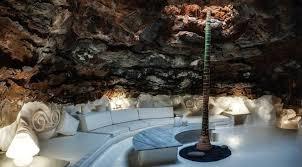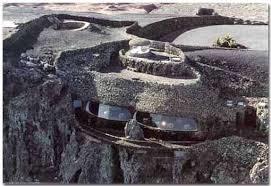Virtual Rewards 3.0 - 2022-2023
This Virtual Cache is part of a limited release of Virtuals created between March 1, 2022 and March 1, 2023. Only 4,000 cache owners were given the opportunity to hide a Virtual Cache. Learn more about Virtual Rewards 3.0 on the Geocaching Blog.
César Manrique:
Nacido el 24 de abril de 1919 en Lanzarote y fallecido en accidente de trafico el 25 de septiembre de 1992 también en Lanzarote.
Tras el golpe de estado se alisto como voluntario en el bando franquista.
Concluida la guerra empezó a estudiar arquitectura técnica en la universidad de La Laguna, abandonándola a los dos años para trasladarse a Madrid. Ingresó en la Escuela Superior de Bellas Artes de San Fernando donde se graduó como profesor de arte y pintura en 1945.
En 1964 se traslada a Nueva York y tuvo contacto con las corrientes artísticas estadounidenses.
En 1966 se instala definitivamente en Lanzarote. Durante las décadas de los 70 y 80 tuvo gran actividad como creador de espacios integrados en el entorno natural.
Durante esta época Lanzarote comenzaba a desarrollarse turísticamente, preocupado por las implicaciones de este desarrollo, Manrique participa activamente en actos de protesta y denuncia para defender los valores paisajísticos y culturales convirtiéndose en un símbolo activo de esa defensa.
-Pintura
Fue uno de los pioneros del arte abstracto en España.
En la década de los sesenta realizó múltiples exposiciones en España, Alemania, Inglaterra, Suecia, Italia, Austria, Brasil, Japón, Estados Unidos y Finlandia.
-Arquitectura
La más importante obra de arte de César Manrique es Lanzarote. Su influencia y su obra han marcado el aspecto externo de la isla. Los lanzaroteños dicen que ha sido él el que "ha hecho" la isla.
César Manrique lo que quería era seguir con el estilo tradicional respecto a la arquitectura. Le decía a los paisanos que en vez de construir con materiales “feos” o no tradicionales, que lo hicieran con los “clásicos”. También llego a convencer al gobierno de Lanzarote para que no pusiesen elementos que no cuadrasen en el paisaje de la naturaleza (vallas publicitarias, carreteras).
-Escultura
Cada una de sus obras escultóricas tienen una personalidad diferente. En cada oportunidad recurría a la utilización de aquellos materiales que le parecían más convenientes.

Er wurde am 24. April 1919 auf Lanzarote geboren und starb am 25. September 1992 bei einem Verkehrsunfall, ebenfalls auf Lanzarote.
Nach dem Staatsstreich meldete er sich als Freiwilliger auf der Seite Francos.
Nach dem Krieg begann er ein Studium der technischen Architektur an der Universität von La Laguna, das er nach zwei Jahren abbrach, um nach Madrid zu ziehen. Er trat in die Schule der Schönen Künste von San Fernando ein, wo er 1945 seinen Abschluss als Professor für Kunst und Malerei machte.
1964 zog er nach New York und kam in Kontakt mit amerikanischen Kunstströmungen.
Im Jahr 1966 ließ er sich dauerhaft auf Lanzarote nieder. In den 70er und 80er Jahren war er als Schöpfer von in die natürliche Umgebung integrierten Räumen sehr aktiv.
In dieser Zeit begann sich Lanzarote als Reiseziel zu entwickeln, und Manrique war besorgt über die Auswirkungen dieser Entwicklung. Er beteiligte sich aktiv an Protestaktionen und Denunziationen, um die Landschaft und die kulturellen Werte zu verteidigen, und wurde zu einem aktiven Symbol dieser Verteidigung.
-Malerei
Er war einer der Pioniere der abstrakten Kunst in Spanien.
In den 1960er Jahren hatte er zahlreiche Ausstellungen in Spanien, Deutschland, England, Schweden, Italien, Österreich, Brasilien, Japan, den Vereinigten Staaten und Finnland.
-Architektur
Das wichtigste Werk von César Manrique ist Lanzarote. Sein Einfluss und sein Werk haben das äußere Erscheinungsbild der Insel geprägt. Die Einwohner von Lanzarote sagen, dass er es war, der die Insel "gemacht" hat.
César Manrique wollte den traditionellen Stil der Architektur beibehalten. Er sagte den Einheimischen, dass sie nicht mit "hässlichen" oder nicht traditionellen Materialien bauen sollten, sondern mit den "Klassikern". Es gelang ihm auch, die Regierung von Lanzarote davon zu überzeugen, keine Elemente aufzustellen, die sich nicht in die natürliche Landschaft einfügen (Werbetafeln, Straßen).
-Skulptur
Jede seiner Skulpturen hat eine andere Persönlichkeit. Bei jeder Gelegenheit griff er auf die Materialien zurück, die ihm am geeignetsten erschienen.

Born on 24 April 1919 in Lanzarote and died in a traffic accident on 25 September 1992, also in Lanzarote.
After the coup d'état he enlisted as a volunteer on Franco's side.
After the war he began to study technical architecture at the University of La Laguna, leaving after two years to move to Madrid. He entered the San Fernando School of Fine Arts where he graduated as a professor of art and painting in 1945.
In 1964 he moved to New York and came into contact with American artistic trends.
In 1966 he settled permanently in Lanzarote. During the 70's and 80's he was very active as a creator of spaces integrated in the natural environment.
During this period, Lanzarote was beginning to develop as a tourist destination, and Manrique was concerned about the implications of this development. He actively participated in acts of protest and denunciation to defend the landscape and cultural values, becoming an active symbol of this defence.
-Painting
He was one of the pioneers of abstract art in Spain.
In the 1960s he held numerous exhibitions in Spain, Germany, England, Sweden, Italy, Austria, Brazil, Japan, the United States and Finland.
-Architecture
César Manrique's most important work of art is Lanzarote. His influence and his work have marked the external appearance of the island. The people of Lanzarote say that it was he who "made" the island.
César Manrique wanted to continue with the traditional style of architecture. He told the locals that instead of building with "ugly" or non-traditional materials, they should build with the "classics". He also managed to convince the government of Lanzarote not to place elements that did not fit in with the natural landscape (billboards, roads).
-Sculpture
Each of his sculptures has a different personality. At every opportunity he resorted to the use of those materials that seemed most suitable to him.

Para registrar este virtual únicamente hay que hacerse una foto con algo identificativo de vuestro equipo en la que se vea el icónico coche que hay en las coordenadas.
To log this cache, all you have to do is take a photo of yourself with something that identifies your team, showing the iconic car at the coordinates.
Um diesen Cache zu registrieren, müssen Sie nur ein Foto von sich mit einem Gegenstand machen, der Ihr Team identifiziert und das ikonische Auto an den Koordinaten zeigt.
Horario:
Lunes a Domingo de 10:00 a 18:00.
